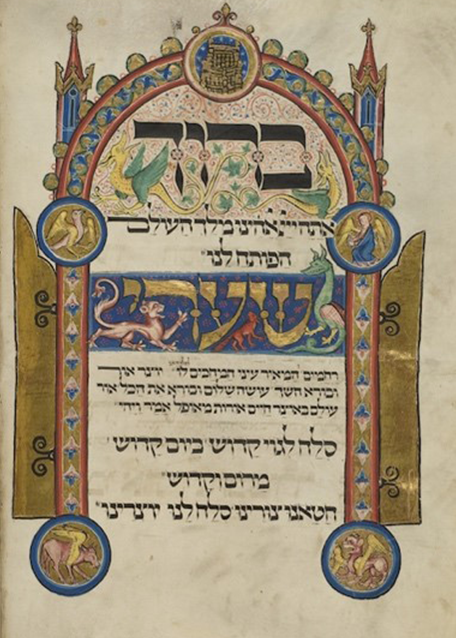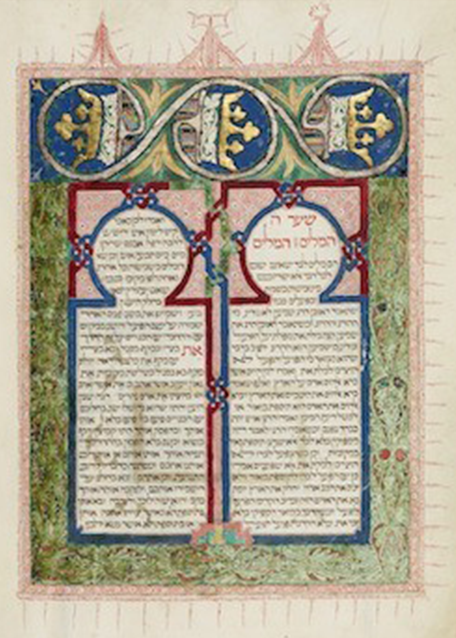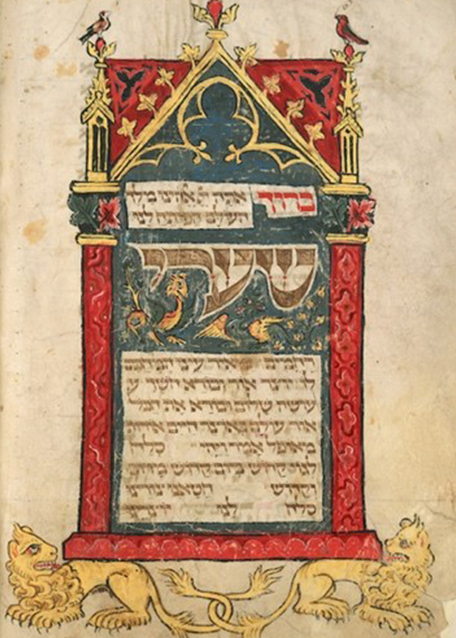
Wrocław Mahzor (Holiday Prayer Book), Germany, 13th century
|
“Blessed is God who opens to us the Gates of Mercy”
A prayer recited during morning service on Yom Kippur
Curator: Andrea Simon
Medium: Reproduction, vinyl on wall
Credit: University Library, Wrocław, Poland, Ms. Or. I 1, f. 90v
Location: Kalifer Culture Hub
The images are taken from medieval Mahzors (holiday prayer books). They date back to the late 13th- early 14th century, testifying to the unity of a global diaspora that had taken Jews as far east as Afghanistan and China, and westward to the edge of the New World. On each page, the Gate frames the same key prayer: “Open unto Us,” from the morning service of Yom Kippur, asks God, on this particularly sacred day, to open the Gates of Mercy to the worshipper’s repentant heart. It is striking that each individual prays on behalf of the whole community: What is a Jew in solitude? asks Adrienne Rich in her poem YOM KIPPUR 1984.
The Gate, שער SHA’AR, is one of the most primal and passionate images in the Hebrew Bible.
It expresses both a fierce commitment to justice—Hate evil and love good / And establish justice in the gate, the prophet Amos proclaims—and the most intimate kind of personal longing for union with God, the Beloved, which is where we began.
As Ibn Gabirol’s poem tells us: ליוֹם בּוֹאך עדי That day, you will come to me.
What quest, what questions, what desire keeps you moving forward?
What “Gate long closed” do you wish to open?
|
|

Kennicott Bible , La Coruña, Spain 1476
|
This is among the most richly illuminated Hebrew Bibles in the world, deftly combining Jewish, Islamic and Christian motifs into a beautifully integrated whole.
Curator: Andrea Simon
Medium: Reproduction, vinyl on wall
Credit: Bodleian Libraries, University of Oxford, Bodleian Library MS. Kennicott 1, fol. 438v
Location: Kalifer Culture Hub
This glorious manuscript page takes the form of a double-gated “Moorish Arch”, clearly meant to evoke the architecture of Muslim Spain. The text here is a scholarly essay on Biblical grammar—the “Gate” or “Key”—that is often included in Medieval Hebrew Bibles from the Iberian Peninsula: you can see the Hebrew word שער in the keyhole-shaped arch on the right.
The Kennicott Bible is the work of the scribe Moses Ibn Zabarah and the illuminator Joseph Ibn Hayyim. It was created in Spain in 1476, when Islamic rule in much of Spain had been over for more than three centuries. In this work, two Jewish artists in Christian Spain are paying homage, through the use of Islamic imagery, to a lost time when Jews, Muslims and Christians lived together in relative calm.
Once again, the Book—if you know how to read it—is a time machine, a magical Gate that invites us to enter a distant, longed-for past.
|
|

David Bar Pesach Mahzor (Holiday Prayer Book), Germany, 14th century
|
“Blessed is God who opens to us the Gates of Mercy”
A prayer recited during morning service on Yom Kippur
Curator: Andrea Simon
Medium: Reproduction, vinyl on wall
Credit: New York Public Library, Dorot Jewish Division
Location: Kalifer Culture Hub
The images are taken from medieval Mahzors (holiday prayer books). They date back to the late 13th- early 14th century, testifying to the unity of a global diaspora that had taken Jews as far east as Afghanistan and China, and westward to the edge of the New World. On each page, the Gate frames the same key prayer: “Open unto Us,” from the morning service of Yom Kippur, asks God, on this particularly sacred day, to open the Gates of Mercy to the worshipper’s repentant heart. It is striking that each individual prays on behalf of the whole community: What is a Jew in solitude? asks Adrienne Rich in her poem YOM KIPPUR 1984.
The Gate, שער SHA’AR, is one of the most primal and passionate images in the Hebrew Bible.
It expresses both a fierce commitment to justice—Hate evil and love good / And establish justice in the gate, the prophet Amos proclaims—and the most intimate kind of personal longing for union with God, the Beloved, which is where we began.
As Ibn Gabirol’s poem tells us: ליוֹם בּוֹאך עדי That day, you will come to me.
What quest, what questions, what desire keeps you moving forward?
What “Gate long closed” do you wish to open?
|
|